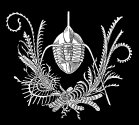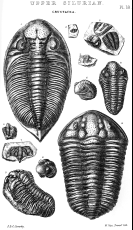Trilobites in Murchison's Siluria
 Sir Roderick Impey Murchison published a comprehensive work on the
Silurian System in Great Britain and elsewhere in 1838. Initially
comprising rocks approximately the interval now known as
Silurian, Murchison's definition of Silurian later expanded to encompass
much of the pre-Old Red Sandstone (i.e. pre-Devonian) Paleozoic
rocks in Great Britain, including intervals now considered to be Cambrian
and Ordovician in age. His book, Siluria described the geology
and fossil content of much of the Paleozoic, and provided excellent
illustrations of much of the flora and fauna. This document provides
a sampling of trilobite illustrations from the fourth edition,
published in 1867:
Sir Roderick Impey Murchison published a comprehensive work on the
Silurian System in Great Britain and elsewhere in 1838. Initially
comprising rocks approximately the interval now known as
Silurian, Murchison's definition of Silurian later expanded to encompass
much of the pre-Old Red Sandstone (i.e. pre-Devonian) Paleozoic
rocks in Great Britain, including intervals now considered to be Cambrian
and Ordovician in age. His book, Siluria described the geology
and fossil content of much of the Paleozoic, and provided excellent
illustrations of much of the flora and fauna. This document provides
a sampling of trilobite illustrations from the fourth edition,
published in 1867:
Murchison, Sir Roderick Impey, 1867. Siluria. Fourth edition.
A History of the Oldest Rocks in the British Isles and Other Countries;
With sketches of the Origin and Distribution of Native Gold, the
General Succession of Geological Formations, and Changes in the
Earth's Surface. John Murray: London, p.1-566, pl.1-41.
These illustrations are anatomically pretty accurate, and are quite
artistic. The copyright has also expired, so feel free to use these
as you like.
 Calymene blumenbachii Brongiart and C. tuberculosa Salter (128Kbytes)
From plate 17 and 18. Figure 11 is the C. tuberculosa specimen.
Calymene blumenbachii Brongiart and C. tuberculosa Salter (128Kbytes)
From plate 17 and 18. Figure 11 is the C. tuberculosa specimen.
 Plate 18, "upper Silurian" fossils (232Kbytes)
This time interval corresponds approximately to the current definition
of middle and upper Silurian (post Llandovery).
Plate 18, "upper Silurian" fossils (232Kbytes)
This time interval corresponds approximately to the current definition
of middle and upper Silurian (post Llandovery).
- Fig.1. Phacops caudatus Brogn. W.L. Shropshire and Dudley.
[This is now assigned to Dalmanites.]
- Fig.2,5 Phacops downingiae Murch. W.L. Dudley. [This is
now assigned to Acaste.]
- Fig.3,4 Tails of young specimens. From Ludlow Rock, Pembrokeshire.
- Fig.7,8 Acidaspis brightii Murch. W.L. Malverns and Dudley.
- Fig.9 Encrinurus variolaris Brogn. W.L. Dudley.
- Fig.10 Calymene blumenbauchii Brogn. W.L. Dudley.
- Fig.11 Calymene tuberculosa Salter W.Sh. Burrington, Shropshire.
Andrew MacRae
macrae@geo.ucalgary.ca


 Calymene blumenbachii Brongiart and C. tuberculosa Salter (128Kbytes)
From plate 17 and 18. Figure 11 is the C. tuberculosa specimen.
Calymene blumenbachii Brongiart and C. tuberculosa Salter (128Kbytes)
From plate 17 and 18. Figure 11 is the C. tuberculosa specimen. Plate 18, "upper Silurian" fossils (232Kbytes)
This time interval corresponds approximately to the current definition
of middle and upper Silurian (post Llandovery).
Plate 18, "upper Silurian" fossils (232Kbytes)
This time interval corresponds approximately to the current definition
of middle and upper Silurian (post Llandovery).